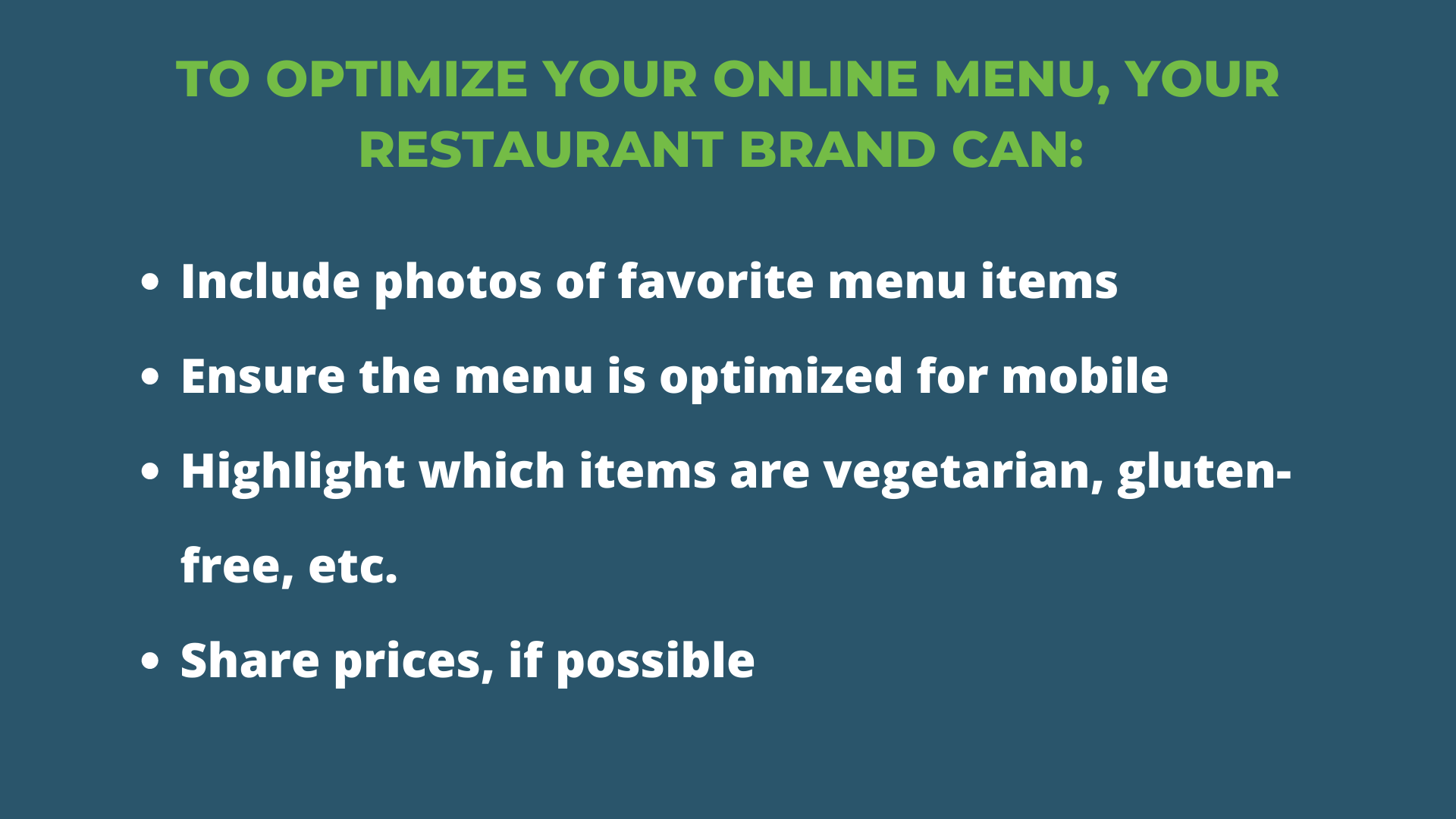6 Fresh Localized Marketing Ideas for Restaurant Brands in 2023

6 Fresh Localized Marketing Ideas for Restaurant Brands in 2023
A recent survey found that 44.5 percent of diners go out to eat at least once a week. Even more impressive, revenue in the online food delivery segment is projected to reach $30.41 billion in 2022.
While Americans love dining or getting delivery from restaurant brands, the competition is fierce. As a restaurant brand, you must constantly evolve your marketing efforts to stand out from competitors and catch the attention of potential diners.
That’s where this blog comes in! We break down six fresh marketing ideas your restaurant brand can leverage to freshen up its marketing strategy in 2023.
1. Boost Your Online Visibility
As a restaurant brand, you want to be visible when a potential diner searches for dining options in their area. One of the best ways to boost online visibility and appear in local search results is through your restaurant brand’s local listings.
If you’re unfamiliar, local listings are an online mention of a business’s name, address, and phone number (NAP), along with a link to its website. You can find local listings in local directories like Google, Yelp, OpenTable, Apple, and more!
Before your restaurant brand begins optimizing local listings, it’s essential to ensure they’re claimed across all locations. Once claimed, you can begin improving them.
Potential diners want to find as much information about your restaurant as possible without having to leave their search results. Customers are 70 percent more likely to visit and 50 percent more likely to consider purchasing from businesses with a complete Google Business Profile (GBP), which are listings on Google Search or Maps.
To optimize your local listings, your restaurant brand must:
- Include helpful business information
- Incorporate calls to action (CTAs) — think order online or join the waitlist
- Reply to reviews within the local listings
- Highlight high-quality photos of dishes and the restaurant’s dining area
- Add extra details such as payment forms accepted, links to social, and more
While local listings are a great way to boost your online visibility, additional tactics can also be leveraged. For a comprehensive list of what your restaurant brand should do to rank higher online, read our restaurant SEO blog and download our Top 10 Things You Should Be Doing in Local SEO Now guide.
2. Establish Loyalty Rewards Programs
With inflation on the rise, potential diners are more conscious about where they spend their money. Loyalty rewards programs are an excellent way for your restaurant brand to stand out from other industry leaders. Whether you’re offering coupon codes, points towards a free appetizer or dessert, or the ability to join a waitlist online, loyalty rewards programs can go a long way.
If your restaurant brand already has a loyalty program, good for you! Is there anything you can do to improve your current model? If you don’t have one, now is a better time than ever to consider it.
Building a loyalty program is no easy task. Restaurant brands must strike the right balance between providing value to customers to keep them coming back while also offering rewards to keep them from using competitors. Examples of restaurants with solid loyalty rewards programs include Jersey Mikes, Chick-il-A, Starbucks, and Nékter Juice Bar, just to name a few.
3. Leverage TikTok
One of our recent Local Memo blogs included details on how millennials use TikTok to find local restaurants. A new survey from MHG of 1,139 U.S. TikTok users finds that 53 percent of millennial users have visited a restaurant they discovered on the platform. Across all generations, some 38 percent of TikTok users have visited or ordered food from a restaurant they saw in a TikTok video.
As a restaurant brand, TikTok provides a significant area of opportunity. While TikTok is still comparably new to other social platforms, a presence on TikTok can differentiate your restaurant from competitors — especially among Gen Z and millennial audiences.
If you’re unfamiliar with the platform, TikTok is a short-form video hosting service that allows users to create and share videos on any topic.
Restaurant brands leverage TikTok to showcase how food is made, participating in viral trends, announcing events and promotions, and highlighting local staff. With more than 1.7 billion monthly active users, a presence on TikTok is a must.
It’s worth noting that while TikTok is essential, this doesn’t mean your restaurant brand should neglect other local social platforms. Check out our Localized Social Content Guide for an in-depth look at what it takes to build a complete local social strategy.
4. Optimize Your Online Menu
We’ll keep this one short and sweet! As a restaurant brand, it’s no secret that potential diners care about your food. Many diners even like to plan what to eat before going to a restaurant. Your online menu is critical.

Again, the more information a potential diner can find about your restaurant brand before deciding to eat there, the better!
5. Work With Food Delivery Services
Food delivery services provide a vast area of opportunity for restaurant brands. While in the past, you may have equated food delivery services with pizza or Chinese food, the landscape has changed. Today, with the help of third-party delivery services, you can get groceries, restaurant food, and much more delivered to you in under an hour.
Third-party delivery for food services is when a restaurant brand outsources its delivery logistics to another company for a commission fee. Uber Eats, Postmates, and DoorDash are all examples of third-party delivery services.
As a multi-location marketer for a restaurant brand, one of your main goals is to increase sales, and third-party delivery services can help you achieve this.
Leveraging third-party delivery services will allow your restaurant brand to:
- Increase online visibility
- Counteract staff shortages
- Expand your customer base
It’s also worth noting that restaurant brands can leverage various third-party delivery services simultaneously. If you’re just getting started, start with one or two. Once you begin to see success, you can consider expanding.
6. Focus on Local Communities
As a restaurant brand with numerous locations, it can be challenging to focus on your local communities. Restaurant brands often have extensive corporate marketing campaigns launched across the country. While these campaigns can improve national branding, speaking to potential diners at the local level is a must.
Data has found that localized content performs 12x better than content not considered localized. Many of the tactics mentioned above will enable your restaurant brand to speak to and interact with communities at the local level. Going local means creating local social profiles, partnering with local nonprofits or charities, and being active in communities and sharing these events or experiences on your local social profiles.
There are a few models to execute your localized marketing strategy effectively — centralized, decentralized, or hybrid.
- The centralized model is where corporate primarily runs all marketing efforts.
- The decentralized model is where individual business locations run all marketing efforts.
- The hybrid model is a combination of the two above. Both corporate and individual business locations collaborate to run marketing efforts.
We typically find that the hybrid model is the most effective. It combines the best of both worlds: the power of local combined with the oversight and support of corporate. It can get overwhelming if each local business is entirely responsible for its marketing efforts.
For additional tips on creating a comprehensive localized marketing strategy to help your restaurant brand stand out from competitors, download our Ultimate Localized Marketing Template for Restaurant Brands.
Crush Your Marketing Goals in 2023 and Beyond
Many multi-location marketers in the restaurant industry don’t have the time to rethink their marketing efforts. Implementing the tactics above will help restaurants perform well in today’s digital-first world.
With 100s or 1,000s of restaurants localized, we understand that adjusting your marketing efforts is no easy task. That’s where SOCi comes in. SOCi is the marketing platform for multi-location brands, including restaurants.
SOCi has all the tools your restaurant brand needs to execute its complete localized marketing strategy within a single login! From local social to reputation management, local listings, and more, SOCi has you covered.
SOCi has partnered with Olo, a leading online ordering SaaS platform for restaurants. In 2019, Olo integrated with Google to allow consumers to order on Google Search and Maps if the restaurant uses Olo’s software.
SOCi’s partnership and integration with Olo allows restaurants to track orders and gain ROI insights around the success of their online listings’ ordering links. With Olo and SOCi, restaurants can track the number of orders that come directly from clicking the “Order ahead” URL in your business listing.
For more information on how SOCi can help your restaurant brand achieve success, request a demo today!








